Geological Heritage NCERT Solutions | Communicative English for Class 10 PDF Download
Textual Exercises
Look at the photograph given below. This is The Three Stooges, a bizarre rock formation that can be found in Goblin Valley. There are some exceptionally unique rock formations all over the world.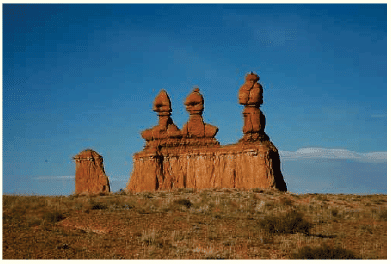 (A) Why do you feel such geological structures should be preserved?
(A) Why do you feel such geological structures should be preserved?
(a) __________
(b) __________
(c) __________
(B) What are the threats to such structures?
(a) __________
(b) __________
(c) __________
Ans:
(A)
(a) They reflect our glorious past.
(b) They are our national heritage.
(c) They can be places of tourists’ attraction.
(B)
(a) Global warming
(b) Natural disasters
(c) Weathering and erosion.
(d) Using stones or rocks as building material in towns and cities.
E.1. Now read about the vanishing rocks of Hyderabad.
One of the most interesting facets of Hyderabad is the mammoth granite rocks in bewitching poses that capture one's eye and imagination. Rocks large and small precariously balance on one another to form shapes that mesmerise the mind. These rocks, among the oldest in the world, are Hyderabad's true heritage. Even the mighty Himalayas at 40-60 million years old are younger than these rocks!
Nature's sculptures
The gigantic boulders inspire creativity and reverence in people, forcing them to look beyond the obvious shapes to create imaginary forms. These rocks seem to strike poses and imitate life-a puppy seated on its hind legs with its front legs raised in the air, a car-shaped formation, flying saucer resting on rocks, four chambers of the heart, and a woman standing with her face to the breeze; these are just a few shapes that tickle your imagination. It is no wonder then that people have taken to naming certain rocks after the shape, they think they resemble, or the idea they think they epitomise.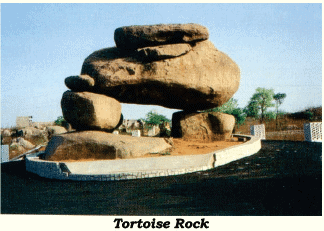
Some of these names have stuck on and the rocks have thus become landmarks in the city. And in some other places, rocks with their symbolic shapes have inspired the devout. Natural openings and cave like structures formed by the rocks have been used as temples by locals. Many people even consider them as symbols of the divine and worship these silent sentinels.
Maintaining ecological balance
Apart from being a visual treat for viewers, these rocks play an integral role in preserving and nurturing the ecological balance of the region. Lakes and ponds have always formed on adjoining rocky patches. This is a natural occurrence as rocks help create the natural drainage system of the area. Subterranean passages created by these rocks result in the natural flow of rain water to that area, aiding the formation of ponds and lakes and recharging ground water levels.
And where there is green, there are birds and bees. Rocky hills often act as the biodiversity hub for the area. Prickly thick shrubs and dry deciduous forests ensconce the rocks. Along the lakebeds, tall grass grows in wild abandon. Often even medicinal plants and aromatic herbs are found in the area. And hidden in this medley of plants are insects, birds and reptiles. So don't be surprised if a Baya weaver flies by or a snake wiggles past you, when you are trekking about the rocks. Fauna and flora of varied kinds thrive in rocky eco-systems. Nature is at its best in these spots and here is where people can go to for a whiff of the wild. But today, such spots are disappearing with alarming alacrity. Rocks are being destroyed indiscriminately; the price the city is paying for growth.
Development at the cost of nature
It is easy to wonder why someone would destroy rocks that are billions of years old. For centuries now, these rocks have been the building material for the city. Even the famous Golconda fort of Hyderabad which sits atop a granite hill is made of the very same granite rock. The problem however lies at the speed and magnitude with which these rocks are now disappearing. Just consider the following statistics. The official 2001 census stated that the Hyderabad population was around 3.7 million. But today, the overflowing buses, traffic jammed streets, and expanding city borders tell a very different story. Today, this natural legacy is giving way to tall residential high-rises and software parks. Hills are being replaced with malls and buildings.
As the massive inflow of population continues, rocks are being quarried roundthe-clock to cater to the exponential boom in the construction industry. Large tracts of land have been approved for residential or commercial use, without taking into consideration what actually lies on the land. The rocks are blown down, land is cleared and the hard crystalline rocks are used as construction material. In the past four years itself, vast stretches of hills around the city's fringes have been turned to rubble or have completely disappeared. If you visit the places where the development is taking place your heart will bleed at the sight of the half quarried, half-eaten mountains.
Growth and development are inevitable and necessary to absorb the growing needs of the economy. But the problem lies, in the fact that none of this growth is monitored. Giant machines dig the earth out and transport mud to all corners of the city. Ratty trucks with broken remains of gigantic rocks can be seen ferrying the roads primarily during dusk or night. Most of this quarrying is illegal. Contractors excavate mud and destroy rocks in remote spots often under the dark cover of night for a paltry sum.
Mass destruction of rocks has exacerbated the depletion of green cover. Precious fauna and flora has been destroyed. Loss of these rocks has meant ground water depletion which has further compounded the city's water woes. Years ago tiny lakes dotted the entire city including the famous Jubilee and Banjara hills localities. Today lakes are found only on the city outskirts in places like Shamirpet. Lakes closer to the city are shrinking with every passing year.
Fighting for Conservation
Though Hyderabad has seen the gradual depletion of rock cover, ecological conservation is an issue that has not found much voice with the population. Most citizens, especially those new to the city, are too busy focusing on seeing a snazzy Hyderabad finding its spot on the global map. But even in this bleak scenario there is a ray of hope for the rocks.
Since 1996, a group of concerned citizens have come together to prevent indiscriminate destruction of the rocks and protect the rocky landscapes. Their organization 'Society to Save Rocks' (STSR) has since then been working hard to preserve the rocky ecosystem in the city and state.
Due to their dedicated campaigning, the Government of Andhra Pradesh has added nine rock formations in Regulation No. 13 of the Hyderabad Urban Development Authority (HUDA) for the protection of Heritage Buildings and Precincts. This act of the governments was hailed by conservationists across the country as a great step in recognising the importance of the rocks and the need to protect them. Today Hyderabad is the only city in India where rocks are protected as a natural heritage. Encouraging the government to preserve these rocks by promoting them as tourist attractions is an alternative that the Society is pushing for.
But despite the dedicated efforts of STSR's the city faces a challenge, as much land in and around the city has already been sold off. Durgam Cheruvu, one of the designated heritage sites is the best place where the government's attempt at conservation and apathy towards rocks, are both visible.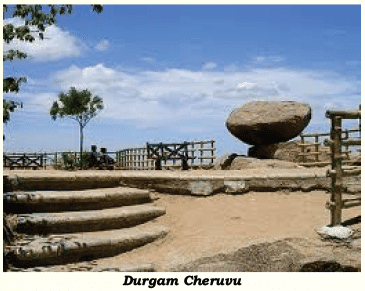 Years ago, the lake lay hidden between rocky cliffs and was inaccessible. A few years ago it was converted to a model tourist spot with boating and other leisure facilities. But entire stretches of hills on one bank of this protected area have been destroyed in the past decade to accommodate the fast-growing Hi-tech city. Durgam Cheruvu thus epitomises the ongoing conflict between development and protection in the city.
Years ago, the lake lay hidden between rocky cliffs and was inaccessible. A few years ago it was converted to a model tourist spot with boating and other leisure facilities. But entire stretches of hills on one bank of this protected area have been destroyed in the past decade to accommodate the fast-growing Hi-tech city. Durgam Cheruvu thus epitomises the ongoing conflict between development and protection in the city.
However some individuals have successfully managed to integrate rocks that abut their house into the structure of their homes. The rock forms as much a part of their home's interior as does their sofa or any other furniture. Some builders and companies too have taken the initiative to include rocks in their building complexes. While they have included a natural rock structure within their building premise, their focus remains on decorative appeal rather than ecological consideration for the rocks.
Over the years, due to the efforts of organizations like the STSR, the rocks of Hyderabad have found a voice. But the din of the construction industry and growing needs of an expanding city are far louder than the voice of these few individuals. What the rocks require are greater public support and a deeper appreciation of their existence. Locals, tourists and governments need to take a pro-active approach to ensure that growth includes preservation of rocks and their eco-systems. After all if a booming economy overtakes billions of years of nature, the consequences and blame will have to be borne by none other than the citizens themselves for the only people who stand to gain will in reality be the ones who lose.
E.2. The box below contains ten words from the passage. Use them appropriately to fill the blanks in the sentences that follow: 1. While food production has shown only marginal improvement, the demand for food grains, vegetables and fruits has registered an ______ growth the world over, forcing governments to initiate urgent measures to establish a balance between supply and demand.
1. While food production has shown only marginal improvement, the demand for food grains, vegetables and fruits has registered an ______ growth the world over, forcing governments to initiate urgent measures to establish a balance between supply and demand.
2. To construct the ______ structure, the builder had to use enormous quantities of concrete.
3. When he returned from the office, he ______ himself in an armchair and asked for a cup of tea.
4. When the teacher saw a student perched ______ on the branch of a tree, she asked him to climb down immediately.
5. The newly appointed office assistant earned the praise of her colleagues for the ______ with which she completed the tasks assigned to her.
6. The new office building was ______ with its bright and fashionable exterior.
7. The pensioner did not get his dues in time on account of the ______ of the officials.
8. The land ______ the post office was procured by the authorities for expanding the building that housed it.
9. Merchants stock up on goods during festival seasons to meet the ______ demand and declare discounts when the sales slacken.
10. During wars armies dig up ______ passages for the movement of troops and supplies unseen by the enemy.
Ans:
1. exponential
2. mammoth
3. ensconced
4. precariously
5. alacrity
6. snazzy
7. apathy
8. abutting
9. booming
10. subterranean
E.3. On the basis of your comprehension of the text fill in the following table.
(a) Importance of rocks
(b) Threats to the geological heritage.
Causes:
(i) ___________
(ii) ___________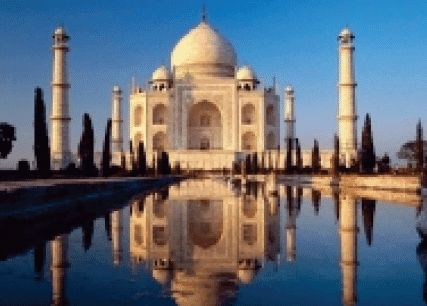
Effects
(i) _________.
(ii) _________.
(c) The hope
(i) The efforts of 'Society to Save Rocks' led to _________.
(i.i) Challenge to the efforts of 'Society to Save Rocks' comes in the form of _________.
(ii) Individuals have made efforts to preserve the heritage by _________.
Ans:
(a) Importance of rocks
Aesthetic importance :
(a) True heritage of Hyderabad
(b) Fascinating shapes
(c) Mind-capturing
Ecological importance :
(a) Helpful in formation of lakes and ponds
(b) Create natural drainage system of the area
(c) Preserve and nurture bio-diversity and ecological balance
(b) Threats to the geological heritage.
Causes
- Expansion of cities
- Illegal and indiscriminate quarrying
Effects
- Depletion of green cover, flora and fauna.
- Depletion of underground water table.
(c) The hope
(i) the addition of nine rock formations in Regulation No. 13 of Hyderabad Urban Development Authority for the protection of Heritage Buildings Precincts.
(i.i) indifference and apathy of government to conserve rocks as well as conflict between development and protection in the city.
(ii) integrating rocks by the side of their houses into the structures of their homes and interiors.
E.4. Select a historical site in need of conservation, research about its historical significance, identify the threatening factors and suggest ways of preserving the geological heritage. Prepare a power point presentation and make a presentation to the class. (This can be done in groups)
For example: The Taj Mahal has been diagnosed with a life threatening disease; Marble Cancer. Experts have predicted that if the air in Agra is not monitored and cleaned, the exterior of the mausoleum would eventually turn black. The application of Fuller's Earth has also disfigured the Taj.
The efforts to protect the monument were started in early 1990's.
- Uptil 1993, 1700 factories in and around Agra were belching out noxious fumes and gases and the Supreme Court ordered the closure of 212 industrial plants in Agra. Cars and buses were barred from crossing the cultural landmark.
- In 1999, the Supreme Court ordered to close 53 iron factories and 107 other plants that harm the Taj.
- Many plants were planted in the Taj nature walk in order to preserve its beauty.
- In 2009, natural gas pipelines were placed to deliver clean fuel to industries in Agra and Firozabad. The three-wheelers previously running on diesel have been replaced by CNG-power and Mathura refinery has been making heavy investments to reduce pollution.
- In February 2010, the government approved a plan to plant one million 'Tulsi' plants near Taj because Tulsi is considered to purify the environment owing to its ability to release high amount of oxygen.
Ans: Image Taken by NASA
Published in Daily Hindustan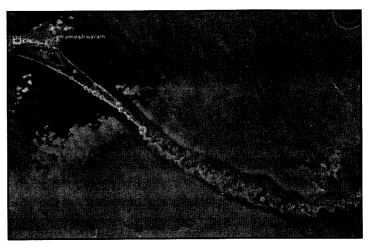 Ram Sethu
Ram Sethu
- Space images taken by NASA reveal a mysterious ancient bridge in the Palk Strait between India and Sri Lanka. The recently discovered bridge currently named as Adam’s Bridge is made of chain of shoals, c. 18 mi (30 km) long.
Historical Significance :
- The bridge’s unique curvature and composition by age reveals that it is man-made. The legends as well as Archaeological studies reveal that the first signs of human inhabitants in Sri Lanka date back to the primitive age, about 1,750,000 years ago and the bridge’s age is also almost equivalent.
Sri Rama and history of Ram Sethu
- Sri Ram was born three yugas ago as per Hindu religious books, so there could be places of the era of Sri Ram. The fact that there was a monument built during the era of Sri Ram was very heartening and encouraging.
Contemporary Researches :
- Geological Survey of India (GSI) has sent a team of scientists to Rameswaram to confirm the authenticity of the picture of RAM SETHU taken by NASA.
- The GSI team, having reached Rameswaram, Dhanushkodi and studying the place shown in the picture, confirmed the underwater formation of rocks attached to each other and described those rocks as old as one lakh years. For further study and excavation, they proposed a detailed project involving marine and scientific assistance and a budget of ₹ 100 crore.
Threatening Factors and Efforts to protect the Ram Sethu
- The news that Sethusamundram Project will be implemented by destroying Ram Sethu is like a severe jolt to us all.
- People and many NGO’s are launching movements against the Sethusamudram Project all over India.
- Every effort is being done to Protect Ram Sethu.
- The destruction of Ram Sethu is not only an insult to Indian culture, but it will also deprive lakhs of fishermen of their livelihood.
- We will have to fight for the cause of protection of Ram Sethu using our united powers.
E.5. Prepare a poster on ‘Let’s Preserve Our Heritage’
Remember
- to include both textual and graphic elements
- to make it easy to read
- to make it easy to understand
- to try for :
- 20% text
- 40% graphics
- 40% empty space
Ans:
Students to prepare a poster keeping in mind the above and using the above information. One is given on the next page.
|
8 videos|250 docs|8 tests
|
FAQs on Geological Heritage NCERT Solutions - Communicative English for Class 10
| 1. What is geological heritage and why is it important? |  |
| 2. How can geological heritage be preserved? |  |
| 3. What role do national parks play in protecting geological heritage? |  |
| 4. What are some examples of notable geological heritage sites in India? |  |
| 5. How does studying geological heritage benefit students and researchers? |  |















